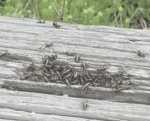Mormon Crickets hatch early

The mild winter and warm spring temperatures may be responsible for the early hatches of a large population of Mormon crickets already being spotted in Elmore County. Ranchers and growers from across the county gathered Monday with the University of Idaho Extension Agent Mir Seyedbagheri, The Board of Elmore County Commissioners, and representatives from the USDA Animal and Plant Health Inspection Services (APHIS), the Idaho Department of Agriculture, BLM and Forest Service to analyze the situation and to develop a plan of control measures for the outbreak. "Populations of grasshoppers and Mormon crickets reach infestation levels in some areas of Southern Idaho nearly every year," said APHIS state plant health director Dave McNeal. The goal of this year's program, as in past years, is to reduce the population outbreak to protect rangeland ecosystems. The federal government recognizes the problem, but requires environmental documentation. Last year a new Environmental Impact Statement was completed to comply with the national regulations. Now the focus is area specific and APHIS is accepting public comment on an environmental assessment before it can begin a suppression program. The public comment period ends April 15.
Populations that trigger the need for a suppression program are normally considered on a case-by-case basis, McNeal said. Complaint forms are available on the agency's website and may be returned by fax. In response to requests from private landowners and government land managers, APHIS will evaluate pest populations and the environmental issues associated with the site. If a determination is made that an outbreak has reached an economically or environmentally critical level, approved chemical control treatments may be applied.
McNeal said there are four treatment options available -- three are sprays and one is bait.
Crickets go through seven stages, or molts, in the 60-90 days before they reach the adult stage. The pesticide sprays are most effective during the early molts. While bait works at all stages, it can only be effective if the pests ingest it.
Elmore County has a total of 193,000 acres, with only 54,000 acres in the hands of private landholders. One cricket can consume up to 38 pounds per acre, causing more than a half million dollars damage. They can travel approximately a mile a day and may migrate as much as 50 miles in a season. Rangeland protection through suppression treatments are hoped to protect forage as well as prevent re-infestation from immigrants. Treatment of hot spots could prevent a wider outbreak.
The BLM has a memorandum of understanding with the federal agency for suppression recognizing APHIS as the lead agency. The Forest Service has "very limited amount for funding" insect control.
County commissioner Calvin Ireland explained that while the county government is aware of the bad problem arising from the cricket infestation, the county does not have the funds to help the farmers and ranchers. The county does hope to cooperate with the highway district to spray the right of way on county roads to help prevent the insect migration. Last year the Idaho Department of Agriculture spent $250,000 to control the outbreak. State funding is limited, but the department hopes to be able to offer a 50/50 cost share program. Ranchers and growers must file a written complaint, noting the treatment area specifically by township and section number. "We can supply the bait. You pick it up from the distribution point and put it out. We are ready to start moving bait into the county."
The County Extension Office will try to facilitate the suppression efforts again this year. Seyedbagheri said "with everyone working together to battle the crickets, we will see what kind of an impact we can have." He encouraged the farmers and ranchers to stop by his office at 535 E. Jackson to mark the township and section of the suppression efforts on the map. Bait supplies will be stored at A-Z Lumber.
